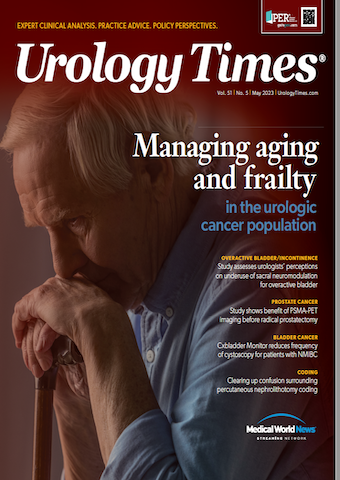Publication
Article
Urology Times Journal
Intravesical gemcitabine/docetaxel for NMIBC appears safe and efficacious
Author(s):
The current study is welcome news as it lends further support to the use of intravesical Gem/Doce as a safe and effective option that has the potential to become a new standard of care for high-risk NMIBC.
Badar M. Mian, MD

For nearly 3 decades, intravesical Bacillus Calmette-Guerin (BCG) has remained the most effective treatment for non–muscle-invasive bladder cancer (NMIBC). Over the past several years, there have been shortages of BCG related to its production and supply to meet the increasing worldwide demand. This has resulted in rationing of intravesical BCG when treating patients with NMIBC. Considering that nearly 75% of newly diagnosed bladder cancers are classified as NMIBC, rationing of BCG poses a significant challenge for patients and urologists. In search of effective and safe alternatives to intravesical BCG, investigators have utilized sequential intravesical gemcitabine and docetaxel, especially in patients with BCG-refractory NMIBC. More recently, prompted by the ongoing BCG shortages, the effectiveness of this sequential combination of intravesical chemotherapy is being evaluated in patients with BCG-naïve NMIBC.
In a recent report, McElree et al present the results of their retrospective cohort study evaluating high-risk NMIBC treatment with intravesical BCG compared with intravesical gemcitabine and docetaxel (Gem/Doce) combination after transurethral resection of the bladder tumor.1 The study included patients undergoing treatment spanning a 10-year period (2011-2021). These patients had de novo high-risk NMIBC. For inclusion in the study, patients had to have received a complete induction course of intravesical BCG and follow-up surveillance studies. The study included 312 patients, of whom 174 received BCG (with or without interferon α-2b [IFN-α-2b]) and 138 patients were treated with combination intravesical Gem/Doce. The Gem/Doce group was significantly older than the BCG group in baseline characteristics (74 years vs 71 years) but had a shorter median follow-up than the BCG group (2 years vs 4 years). The primary outcome was high-grade NMIBC recurrence-free survival. Secondary outcomes included recurrence-free, progression-free, and cystectomy-free survival.
The intravesical BCG protocol included an induction course (weekly x 6 weeks) with 1 full vial of BCG TICE strain (with or without 50 million U of IFN-α-2b) instilled simultaneously into the bladder for approximately 90 to 120 minutes. During BCG shortages, the induction BCG dose was altered to one-third of a vial. Maintenance BCG therapy consisted of a reduced dose (one-third to one-tenth of a vial), which was administered over three 3-week courses at 3 months, 9 months, and 15 months. For patients receiving Gem/Doce, induction course (weekly x 6 weeks) included instillation of 1 g of gemcitabine in 50 mL of normal saline, held int the bladder for 90 minutes, followed by 37.5 mg of docetaxel in 50 mL of normal saline, held for 90 to 120 minutes. Additionally, oral ondansetron, oxybutynin, and naproxen were provided if nausea, bladder pain, or spasms developed. For patients who were disease free at the first surveillance cystoscopy, monthly maintenance therapy was initiated for up to 24 months using similar doses as mentioned above.
The investigators reported that patients receiving Gem/Doce had improved high-grade recurrence-free survival (HG-RFS) at 6 months when compared with BCG (92% vs 76%). At 1 year, HG-RFS estimates were 85% and 71% in the Gem/Doce and BCG groups, respectively. The overall RFS, including all disease grades, was also higher in the Gem/Doce group. The 2-year RFS estimates in the Gem/Doce and BCG group were 78% and 62%, and the progression-free survival was 97% and 92% respectively. After adjusting for age, sex, treatment year, and presence of carcinoma in situ, treatment with Gem/Doce was associated with a lower risk of any recurrence and HG recurrence (hazard ratio 0.56) compared with treatment with BCG.
Assessment of adverse effects (AEs) were reported by 49.4% of patients in the BCG group and by 52.2% in the Gem/Doce group. However, grade 3 to 5 AEs were reported quite infrequently, at 4.0% in the BCG group and 1.4% in the Gem/Doce group. Patients receiving Gem/Doce were more likely to report bladder spasms (21% vs 5.2%) whereas patients receiving BCG reported higher rate of dysuria (12.6% vs 5.1%). Nonsignificant higher rate of nausea was reported in the Gem/Doce group, and fatigue or flulike symptoms are more frequent in the BCG group.
The mechanism of action of both treatments is quite distinct, with BCG requiring host immune response whereas Gem/Doce relies on direct cytotoxicity regardless of the host immune response. This may be responsible for the distinctive response pattern noted by the investigators demonstrating that BCG was associated with a lower response rate than Gem/Doce during the first 6 months, but the response was more durable over the next 2 years.
The efficacy and tolerability of Gem/Doce in this cohort study appear to be at least comparable, if not superior, to BCG. The BCG supply-and-demand equation is not likely be solved in the foreseeable future. Yet tens of thousands of patients with NMIBC will continue to require effective intravesical therapy in order to preserve the bladder and avoid radical cystectomy. The ongoing randomized clinical trials, such as the BRIDGE study (NCT05538663), comparing intravesical BCG and Gem/Doce, will provide invaluable insight into the effectiveness of this combination chemotherapy.
There are a few issues specific to Gem/Doce instillation, such as more complex workflow and longer encounter time, that need to be managed by the healthcare providers and clinic staff. When adequate BCG supply is available, it is still the preferred first-line therapy for high-risk NMIBC due to extensive experience with its known response rate and toxicity profile. However, out of necessity, Gem/Doce is being offered as the first-line intravesical therapy for newly diagnosed NMIBC at our center and many other centers. The current study is welcome news as it lends further support to the use of intravesical Gem/Doce as a safe and effective option which has the potential to become a new standard of care for high-risk NMIBC.
Reference
1. McElree IM, Steinberg RL, Mott SL, O’Donnell MA, Packiam VT. Comparison of sequential intravesical gemcitabine and docetaxel vs Bacillus Calmette-Guérin for the treatment of patients with high-risk non-muscle-invasive bladder cancer. JAMA Netw Open. 2023;6(2):e230849. doi:10.1001/jamanetworkopen.2023.0849





























